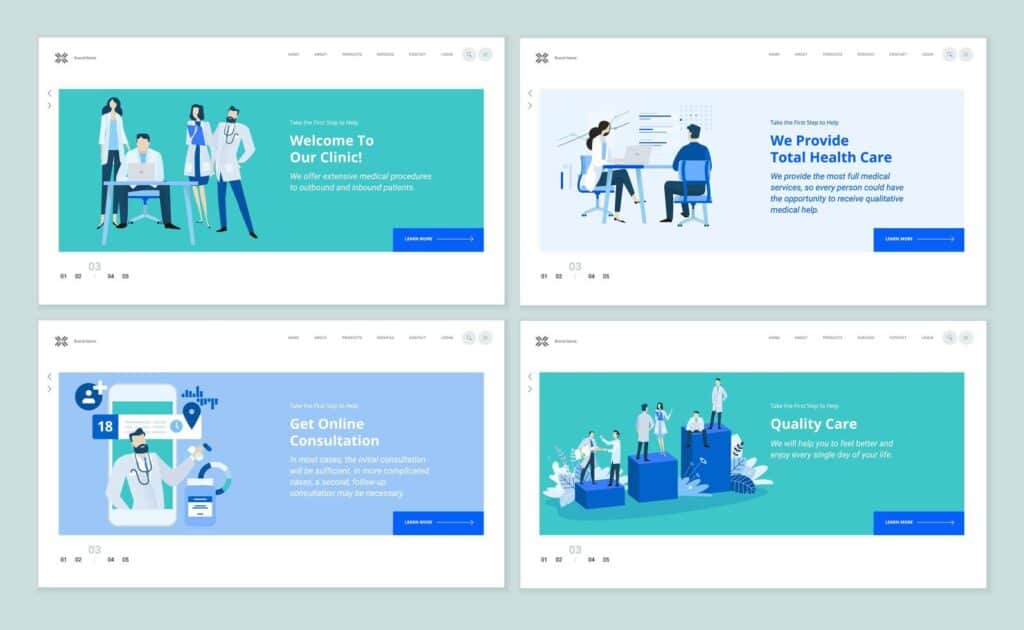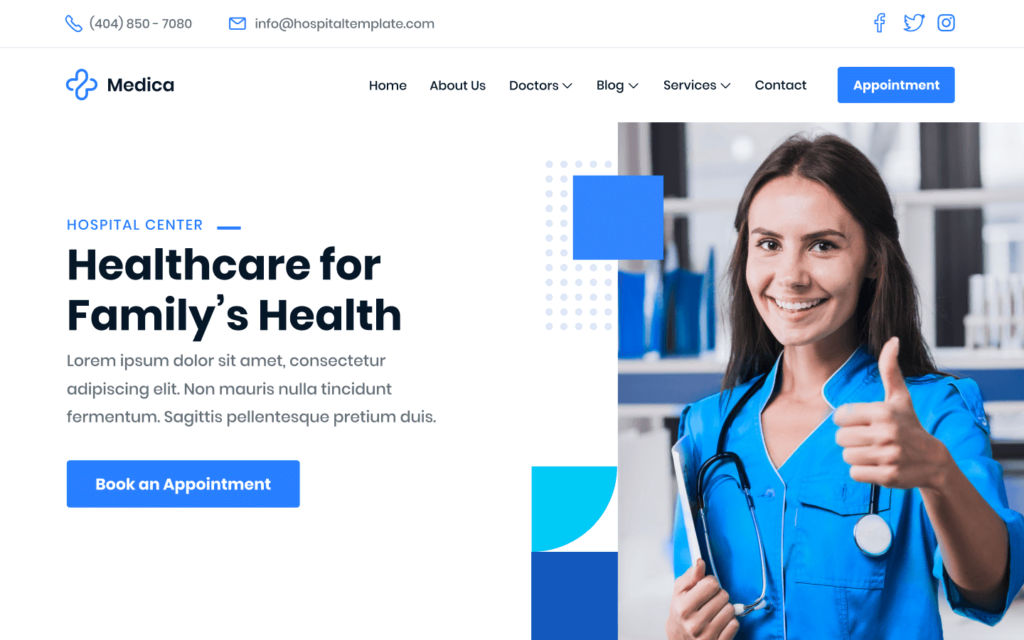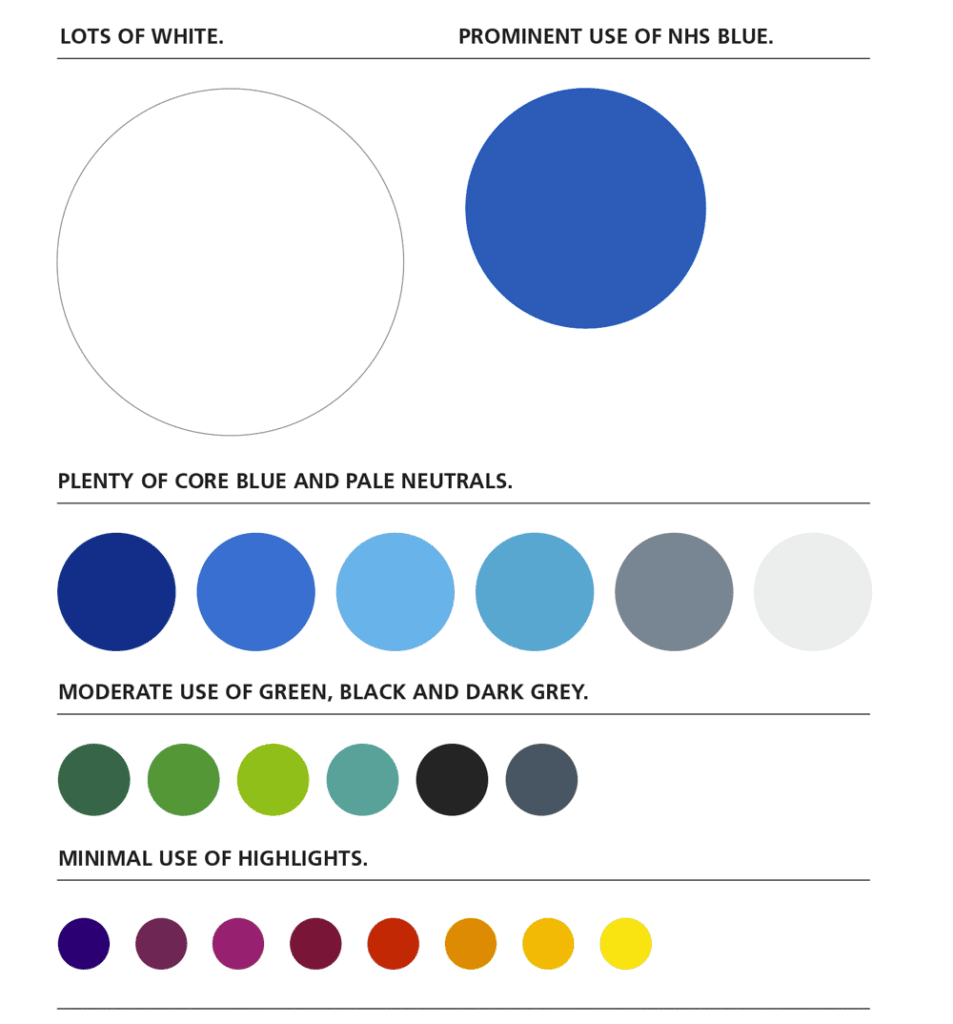The Art and Science of Healthcare Design
“Healthcare” and “design” are words many people don't expect to see in the same sentence. But in reality, we deal with this concept more often than we think.
Every time we visit a hospital, call a doctor, buy medicine at a drugstore, or check a fitness tracker app, the healthcare design can be seen fully. It may not seem meaningful at first glance, but a well-thought-out design can be a difference-maker and affect the lives of millions.
Table of Contents
What is Healthcare Design?

Generally, a designer's role in healthcare systems revolves around planning, building, and renovating various medical facilities, such as hospitals, clinics, pharmacies, care centres, etc. But there's so much more to it than we see on the surface.
Besides keeping the exteriors modern, the interiors clean, and the equipment up-to-date, the designers create an ecosystem where patients and caregivers can co-exist and help each other thrive. The visitors should feel secure and welcome, while the staff needs to have enough tools and space to provide the best medical service possible.
What Problems Does Healthcare Design Solve?
With every healthcare website design project, the designers face multiple issues they must figure out without compromising too much on them. This list can be roughly divided into three major categories:
- Patient-related factors;
- Doctor-related factors;
- General factors.
All three are equally valuable and must be in relative balance to ensure maximum overall productivity.
The Patient's Perspective

Stress-relief and Confidence
For many people, hospitals and other medical facilities are associated with negative emotions related to pain, suffering, or even death. The designer aims to shift the perspective to the opposite side of the spectrum and create a positive image for the hospital and its staff by reducing patients' anxiety and boosting their confidence.
The visitors must feel respected, loved, and genuinely cared for. They should come to healthcare centres without fear and believe they will receive the best possible treatment and become fully healthy.
It starts with the first visual impression before a patient enters the building. We immediately get a sense of rejection from the facility and start doubting the quality of service we might receive there if:
- It's too old, too dull or too dirty;
- The territory has not been well-maintained;
- The parking lot is small or inconvenient.
Once the patients are inside, lousy lighting, noises, tight spaces, and unwelcoming personnel might be put off. All these accumulated effects lead to doubt, poor confidence, and ultimately, a bad overall experience and distrust for all medical institutions in the future.
Comfort
Imagine coming to a dentist for a wisdom tooth removal and sitting on a plain plastic chair for the entire procedure. OK, this is an obvious exaggeration, but this gives you a clear idea about the importance of comfort in a clinic, hospital, or medical centre.
Comfort is mainly associated with furniture, such as chairs, beds, tables, or cabinets. However, the placement and access to the furniture play a huge part in creating a comfortable environment. Besides storage areas and objects to sit on, designers should pay attention to floors, walls, doors, windows, appliances, light switches, and water coolers. Everything patients physically interact with during their stay in the facility.
Navigation
Let's be honest: we all got lost in a hospital at least once. Some buildings, especially older ones, are complicated mazes of hallways and stairs that may lead you to a completely different department.
You can solve this problem with:
- A system of large and clear signs;
- Bright markers inform patients and visitors about their whereabouts and directions to each section.
A detailed map of the place on each floor is another helpful tool that improves navigation and serves as an essential piece in the safety puzzle.
Safety
Maps and signs are essential, but they're just mere drops in the ocean of safety measures you must address during planning.
First, the building has to be rigid and placed on elevated ground to withstand severe weather conditions (earthquakes, floods, etc.) or weapon damage (guns, bombs, heavy machinery). The architects must incorporate a capable ventilation system and a network of sensors and alarms to detect and prevent fires and leaks.
But it doesn't stop with that. Avoiding tight spaces to prevent crowd formation during an evacuation is crucial. The same goes for slippery floors and one-way doors, which may cause injuries and significantly slow down the flow of people trying to leave the building.
Finally, the facility has to be equipped with:
- A bomb shelter;
- A backup power source, like a generator;
- A sufficient medicine and water supply will last several days in case of a temporary lockdown.
Think of hospitals as modern-day strongholds where you can stay as long as needed while being cared for.
The Doctor's Perspective

Efficiency
The primary goal of any doctor or caregiver is to detect and stop whatever bothers their patients and ultimately bring them back to their maximum health. The efficiency of medical staff is usually proportional to their experience and the amount of equipment and medicine available at the facility. However, good ergonomics can elevate the treatment quality to another level, while poor design choices can get in the doctor's way.
The efficiency of any given specialist combines multiple factors, from tools and medication to spacing and logistics. Take any of them out of the equation, and the percentage of successful outcomes can drop significantly.
Productivity
A doctor can't be efficient if they are tired or distracted. The staff must have favourable working conditions and proper rest to limit wear and tear. The former can be boosted by the following:
- Cutting-edge equipment;
- Flexible spacing;
- Smart management.
The latter is almost impossible without a separate resting area with comfortable furniture, nutritious meals, and access to fresh air.
It's also worth mentioning that visitors and non-essential staff should not be freely allowed in either working or resting zones to minimise distraction. The mental health of essential workers, like doctors and police officers, has been a hot topic in the media and scientific reports, giving these people time to rejuvenate and get back to their duties fully charged.
General Perspective
Location and Size
One of the first problems an architect has to solve is the building's location. Most of the time, this parameter cannot be affected, so designers have to work with the cards they were dealt with, forcing them to adapt the size of the future project according to its surroundings. For example, small towns and rural areas allow wider and longer hospitals, while in large cities, there's usually no other option but to build a tall and slim construction.
However, the size of the building does not depend solely on the land options. When choosing between compactness and going all-out, the designers have to take into account both practical and psychological aspects:
- A massive multi-floor tower may scare some patients off, but it adds valuable flexibility points for possible expansions or renovations;
- A small toned-down hospital feels more welcoming and personalised, but it has to cram a lot of stuff into a limited space, and it will not be able to serve a sufficient volume of people.
Ideally, the hospital should have a Floor Area Ratio under 1.0, meaning that a 3-story building must not occupy more than ⅓ of the entire site. Furthermore, the facility must be easy to reach, have access to public utilities and outdoor areas, and look modern but not too bland or sterile.
Cost-Effectiveness and Flexibility
Unless you live in Dubai, every construction project presents the challenge of creating the best possible structure without breaking the bank. The total price reflects the building method and materials but also includes an investment in durability and future growth.
No one wants to be stuck in an endless loop of renovations or be unable to upgrade medical equipment or add a new section because of limited space. Bear in mind that diseases and their treatment methods are constantly evolving.
You can find an intelligent way to prolong the life of an average hospital in modular design solutions that bring room uniformity and allow quick transformations. A modular approach may cost an extra dollar at the building stage but will save a lot of money.
Sanitation
Medical institutions should be kept clean and sanitised at all times. Aside from regular cleaning and ventilation, interior design can also be helpful.
Several rules to follow:
- The materials for the walls and the floors should be resistant to bacteria and easy to clean;
- The patient rooms should have a distinct separation to limit contact;
- The staff must have a closed space to dispose of dirty clothes and appliances.
Maintenance
Even the most minor medical institutions are pretty noticeable on the economic map of their hometowns. They consume a lot of energy and other resources and, on the other end, produce particular types of waste which need to be timely utilised.
Here, the designers must focus on improving sustainability by implementing a flexible system of supplies, transportation, energy, food, water, medicine, equipment, and employees. The end-game goal is to increase the number of reusable resources, reduce waste, and decrease the number of patients by providing more assistance via messengers and video calls.
Critical Elements of Healthcare Design

Healthcare facilities are complicated puzzles that demand attention to many details. They are, first and foremost, result-oriented, but at the same time, a patient is not a broken car or any inanimate object. Hence, hospitals must avoid the image of soulless “fixing” conveyors.
Space
The concept of space in healthcare deserves an entire book, but we can try to grasp some general ideas and essential tips for designing a state-of-the-art hospital.
First of all, let's separate the outdoor territory from the interior. Although it matters less, the area around the hospital still plays a vital role in the facility ecosystem. As mentioned, the site's Floor Area Ratio should not exceed 2.0, even in dense urban areas. You have to leave enough space for the following:
- Parking;
- Lounge zones with greenery;
- Supporting facilities.
The taller and more comprehensive the building is, the more land it needs to have next to it.
The inside of the hospital is a whole other story. Every inch has to be functional, at least to some degree, and serve a specific purpose (sometimes even more than one), but you have to plan what each area is capable and incapable of.
For example, a waiting room can serve as a conference area or even a small store, but you can hardly do anything besides its initial purpose in the X-ray room. However, some equipment is far more mobile than others and should be brought to the patient's room when possible rather than relocating the patient. Such mobility allows doctors to utilise the same space more efficiently and dramatically reduces their patients' stress levels.
This approach aligns with prioritising more personalised single rooms where patients can spend the entirety of their stay at the hospital. The designers should also remember that visitors play a considerable role in the patient's mental health and recovery, so each room should be equipped with the following:
- A couch;
- A dedicated light source;
- A small table (preferably by the window and far from the door) where you can actively engage caregivers or family members in the healthcare process without interrupting the staff.
The importance of spacing can not be stressed enough when separating resting areas from workplaces. Overworking is a severe problem in the healthcare industry, so every staff member needs frequent quality breaks to keep productivity and morale high. This includes a closed room with a bed or a couch for sleep, a lounge or an outdoor space for socialising and a lunch room with hot food and drinks.
Lighting
It's no secret that natural light has a positive therapeutic effect on patients, improving their mood and overall perception of the room. Positioning the bed in the middle part of the layout, adding controllable shades, and removing reflective surfaces have all proven to be excellent solutions for maximising daylighting. Some hospitals like to use glass to increase light penetration and improve maintenance, but adding too much transparency hurts privacy. The designers should implement glass carefully or choose panels with frosting effects.
For nighttime, it's recommended to use strategically placed LED panels with adjustable brightness instead of outdated fluorescent lights that are too bright and cold for anyone's liking. Patients with limited mobility can benefit from motion sensors in restrooms or the main compartment.
Colours

In the past, most hospitals had predominantly white, grey, or light-blue colour palettes, which helped create a sense of cleanliness. Luckily, in the 21st century, this pastel trend has given way to more natural earthy tones that create a calming effect on the patients and positively influence their healing process.
The following colours have occupied hospitals all over the world, destroying the boredom of traditional medical facilities:
- Wooden brown;
- Forest green;
- Honey yellow;
- Ocean blue;
- Sunset orange
Even red, usually associated with blood and aggression, is frequently featured in some design elements and integrated into branding.
Colour is invaluable for zoning, helping to distinguish functional areas and guide visitors without using artificial barriers like walls and doors. This makes a hospital feel more open and welcoming but, at the same time, provides visual space hierarchy.
By making a hospital look like an actual living place rather than a cold, sterile institution, the designers are changing the narrative and bringing healthcare closer to people. Even children, who dislike hospitals and clinics, become more engaged in healthcare activities when they see bright colours and have access to fun interactive environments, like playgrounds or waiting rooms, on the site.
Sound
A hospital is far from the quietest place in the world, and over 40% of patients cite noise as one of the most annoying factors in modern healthcare institutions. An average patient room is filled with an ambient buzz from medical equipment and air conditioners, conversations from visiting doctors, and sound leaks from the outside hallways or neighbouring rooms – 24 hours a day, seven days a week.
Creating a quiet environment starts at the planning stage:
- Locating the patient rooms away from the doctor's office;
- Applying advanced isolation materials with excellent vibration-absorbing qualities;
- Choosing softer materials and furniture with fewer moving parts.
Unfortunately, you cannot alter some parameters. For example, smooth floor surfaces are designed specifically for quick navigation through the building but also serve as notorious noise amplifiers.
Music is another aspect of the hospital's acoustic environment that is often overlooked. It's been known for a while that calm classical melodies have a soothing effect on the patient's neural system and can lower blood pressure and heart rate. At the same time, rhythmic tunes can accelerate the recovery of temporarily disabled people.
In general, having access to their favourite tunes makes patients less stressed and more distracted from the potential fear of the therapy.
Materials
More and more hospitals prefer to avoid shiny metal elements (except medical tools) in their design and prefer going in a warmer and more tactile direction. For example, copper has recently emerged as a surprising substitute for steel and aluminium thanks to its antibacterial properties and more pleasant feel.
Natural elements are also becoming a staple in healthcare, with many wooded details and natural plants reaching waiting areas and patient rooms. Slightly rough textures, like brick or unpolished wood, and natural lighting make hospital spaces more peaceful and down-to-earth.
Plastic remains one of the most popular materials in the world, and it's used in healthcare to replace metal when possible, especially in medical equipment. Brightly coloured plastic chairs and tables help with interior customisation and zoning, while their soft matte finish is tactile and pleasant. Healthcare facilities can get extra sustainability points by using furniture made from recycled materials.
What Will Hospitals Look Like 25 Years from Now?

Modern healthcare design is aimed at humanising medical facilities and maximising their efficiency. Hospitals and clinics are becoming more than just care stations, creating a healing environment instead of providing bare treatment. Accelerated by the equipment and methodology evolution, by 2050, healthcare will embrace its new identity that the following traits can characterise:
- Personalised – Putting the patients in the middle of the healthcare design system will shift the focus from traditional facilities and remove the boundaries of where and when they can receive help. Hospital rooms will allow people to stay for an extended period by transforming patient rooms into advanced hubs with more equipment and comfortable interiors. Waiting areas will offer more space and privacy for adult visitors and more entertainment for children;
- Customised – All hospital areas will no longer serve only one purpose and instead embrace the utility mentality. Multi-purpose rooms with modular design will significantly increase flexibility and let the doctors do more within one particular workspace. You can quickly repurpose outdated or rarely used areas for new treatment methods and modernised equipment, which will allow for cutting plenty of time and costs;
- Self-sustainable – Efficient recycling, intelligent energy and healthcare data management, which are used in tools like FHIR, will be critical elements of future care centres. Hospitals will be equipped with clean energy sources, such as solar panels, and cut the production of carbon dioxide, positively affecting the neighbourhood's ecosystem;
- Virtual – Medicine has long ago left the hospital walls and can now be found on the screen of our computers and smartphones. Digital technologies have helped increase the number of people receiving timely help or advice while reducing the crowds in medical facilities. Now, healthcare design includes physical buildings, apps, and software for monitoring health and interacting with specialists.
Conclusion
As you can see, exterior and interior design are as essential in healthcare as in any other aspect of people's lives. It's usually hard and even impossible to enjoy a stay at a hospital, but an intelligent healthcare design can make the time spent there more tolerable.
Author Bio: Dmytro Sokhach is an entrepreneur and a 6-Figure Flipper Club member. Founded Admix Global (web agency) that builds websites, makes them profitable and sells them as a business.
